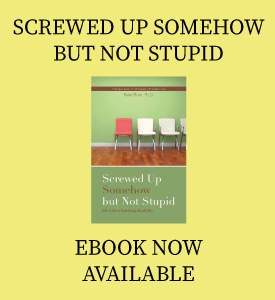In this article I introduce the analogy of learning disabilities (or any disability) as a mountain between where you are and where you want to go. In the current article, I discuss academic problems for people with NLD.
The mountain of academic problems with nonverbal learning disabilities
Many people with nonverbal learning disabilities have few academic problems. Those that do tend to have problems in a few areas:
1. Graphomotor problems \dash poor handwriting, which can lead to illegible answers, or to arithmetic errors from misreading our own writing.
2. Speed of processing problems \dash these are especially problematic on timed tests, where many NLDers have difficulty finishing on time.
3. Problems in some areas of mathematics, especially those that require abstract thinking, particularly abstract visual thinking.
Giving up on academics with nonverbal learning disabilities
Giving up on academics, or saying you didn’t really want to get to the other side of the mountain, is straightforward: Drop out of school. Unfortunately, this poses a lot of problems for employment, especially as many of the jobs that do not demand much education are ones that NLDers are bad at (e.g. waiter/waitress, supermarket worker, some kinds of sales jobs, acting), and so on. They often demand physical coordination and speed, or, in the case of sales, rapidly sensing what another person is feeling, and forming bonds with others quickly. Fortunately, many NLDers actually like school and do fairly well at it (although some may need various accommodations, which I will discuss in another article). In addition, many NLDers have significant problems with mathematics, although this is not universal by any means. Giving up on academics, certainly before graduating high school, is a last resort; it is probably not an option that many NLDers will have to use.
Going through the mountain of academics when you have NLD
This is probably the area where going through the mountain is most recommended; it may also be the area where it is most useful, particularly if you are not working while in school. It is possible to study more hours than most kids do. It may not be fun, it may not be desirable, but it is possible, and there are many successful NLDers who did it . This strategy can be combined with some from going over the mountain and some from going around the mountain, so that you study a little more than average, take a little longer than average, and use your ingenuity to deal with some difficulties.
Going over the mountain of academics when you have nonverbal learning disabilities
Going over the mountain involves trying harder. This can be done in academics, too. One way to do this is to hire a tutor, or use your school’s tutoring facilities, if they exist. A less expensive alternative is to buy additional books – many courses now have study guides available.
Going around the mountain of academics when you have NLD
I am going to take this subject by subject.
Mathematics offers tremendous opportunities for going around the mountain of NLD. For example, when you need to learn the multiplication table, you can do it purely by rote (which some, but by no means all, NLDers seem to be good at) or you can learn tricks. I hated rote memory work, so I devised a lot of tricks, as follows:
2 times is one that few people seem to have trouble with. One way of doing it, though, is to just add the number to itself.
3 times is another that a lot of people just get. But you can add the number to twice the number. For example: 8*3 = ??? Well, twice 8 is 16, and 16 + 8 = 24. You can partially check your answer by adding the digits in the answer and seeing if it is a multiple of 3 (it should be…..for example, with 24, we add 2 and 4, to get 6, which is a multiple of 3.
4 times is just twice twice.
5 times If you feel comfortable dividing by 2 (cutting in half) then you can add a 0 and then divide by 2 (e.g. 7*5=????, add a 0 to 7 to get 70. Cut in half to get 35). If you don’t like cutting big numbers in half, you can cut the original number in half, rounding down, and then add a 5 if you needed to round (e.g. 7*5 = ????, cut 7 in half and round down to get 3, add a 5 (because you had to round) to get 35. If you don’t need to round, you add 0.
9 times (Yes, I know I skipped 6, 7, and 8, I’m coming back to 8, and will talk about 6 and 7). There are several tricks for 9. Here are two I like:
The finger trick. Hold out your hands, fingers spread, palms away from you. Your left pinky is finger number 1, your left ring finger is finger 2, and so on. To multiply a number by 9, hold down the corresponding finger. Then, the tens digit is the number of fingers to the left, and the units digit is the number of fingers to the right. For example: 9*6=???? Finger 6 is your right thumb. Fold it down, and there are five fingers to the left and four to the right, so the answer is 54.
The subtract 1 then subtract from 9 trick. To multiply by 9, subtract one from the number you want to multiply, that’s the tens digit. Then subtract that number from 9, and that’s your units digit. For example 9*7 = ???? Well, 7-1 = 6 and 9-6=3 so the answer is 63.
8 times. Multiply by 9, then subtract the number that you are multiplying. For example, 8*6 = ???? well 9*6=54 and 54-6 = 48 so the answer is 48. If you are using the finger trick, you can reduce the short term memory demands by leaving the finger down.
6 and 7 times OK. I admit it. I don’t have tricks for these. But that only leaves three multiplication facts to learn: 6*6, 7*6 and 7*7; you can probably manage that.
Two other skills that are very useful ways around the mountain are stimation and digit checking. Estimation involves getting a quick idea of the approximate answer. For example, in a multiplication problem, the number of digits in the answer is always either the sum of the number of digits in the two multiplicands, or one less than that. This is more clearly shown in an example. Suppose, for instance, the problem is 342 * 12
Well, 342 has 3 digits, and 32 has two digits, so the answer must have either 3+2 = 5 digits or one less that that (4 digits). If you have a long division problem, this method can be used to check if your answer is possible.
Digit checking means that certain final digits are possible. For example, in the above problem of 342*12, the final digit of the answer must be 2*2 = 4; for another example, if the problem is 12863 * 232, you can tell that the answer must have either 5+3=8 digits or one less than that; and the last digit must be 3*2= 6.
Quite a variety of digit checks exist. For example, if the problem involves squaring a number, the last digit must be 0, 1, 4, 5, 6, or 9.
There are also a number of divisibility tricks (one number is divisible by another if a dividing one by the other leaves no remainder). Divisibility by 3 (and 9) can be checked by adding up the digits and seeing if the result is divisible by 3 (e.g., 4643 annot be the result of multiplying an integer by 3 (or 9), because 4+6+4+3 = 17 which is not divisible by 3. number is divisible by 4 if, and only if, the last 2 digits of the number are divisible by 4 (e.g 4,222,312,148 is divisible by 4 because 48 is). Similarly, a number is divisible by 8 only if the last 3 digits are (so the number above is not divisible by 8, because 148 is not). A number is divisible by 5 if the last digit is 0 or 5, and a number is divisible by 6 if it is divisible by 3 and it is even. I know of no simple divisibility trick for 7.
Expository writing
Many NLD people have trouble with writing, especially with the longer essays that are required in high school and college. It’s usually not so much the writing itself as the organization that causes problems. One method that I have found useful is what I call super-outlining. Start with a main topic. This might be assigned by the teacher, or it might be your choice. It could also be a limited choice – for instance, you might be required to write an essay about one of the Presidents of the United States in the 20th century, but have a choice about which. Once you have a main topic, you make sections and write a bit (say, a paragraph or two) about each. For a short essay, that might be enough. If not, divide each section into subsections, and write about each of them. Keep going until your essay is about the right length, then fix the format and punctuation, work on the flow between sections, and you are done. A very long work might have many levels.
Foreign languages
I was never very good at foreign languages. I studied Spanish in high school, studied French and, much later, lived in Israel and studied Hebrew. I have a couple hints for NLD students of foreign languages, based on my own experience and that of others:
1. Don’t try to learn a language with another script.
2. When learning vocabulary, try to come up with cognates (words that sound similar and have similar meanings). If I were learning Spanish now, I would list vocabulary in three columns: Spanish, English, and Cognate. This is easy with the Romance languages, particularly if, like many NLDers, you know English well. For example, the Spanish for `Earth’ is `Terra’, which doesn’t seem to be a cognate, but there are words like `terrarium’ and `terrestrial’.
Science NLDers often have a lot of trouble with the laboratory parts of some sciences, due to our poor visual spatial abilities and our lack of coordination. One way around this mountain is to try to find someone who is good at the laboratory parts of science, but not as good with the theory, and see if you can be partners. Since many NLDers are good at writing, it might be that one partner could do the experiments while the other writes it up (be sure to OK this with your teacher).



I’m sending this on to my son. It’s interesting, he was given a label of “educationally autistic” by his developmental preschool because he didn’t qualify for autism by the neurologist. So…he was kind of treated “behaviorally”, especially at the last, before we started homeschooling in 9th grade.
Thing is, and it’s my fault, too, he has severe graphomotor , processing, and calculation problems. Did you write this for us? (ha!)
My point is, one day he was talking about middle school and I thought he was going to tell me he was bullied by a classmate or something, but he said, no, he was “bullied by the curriculum.” All those years all those mountains being climbed without any accommodations or special teaching.
They really are mountains.